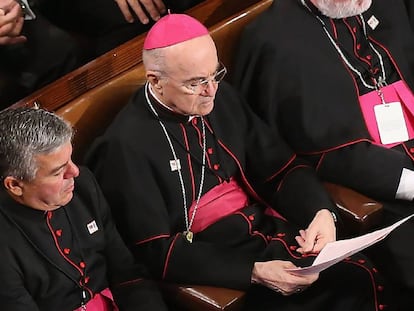Raniero Mancinelli, the tailor of the popes, who is preparing to dress the new pontiff
‘He always smiled at me; he seemed more like a brother than a pope,’ he recalls of Francis while working on his successor’s white cassock in three different sizes. Near his small workshop in Rome is Antonio Arellano’s artisan shoe shop, where John Paul II and Benedict XVI were customers
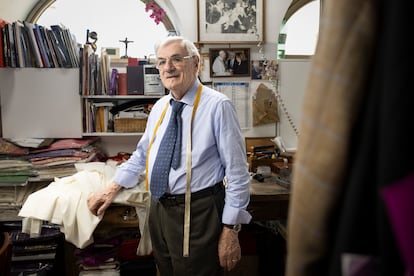
The new pope elected in the conclave that begins on May 7, who will be presented to the world from the balcony of St. Peter’s Basilica, will wear one of the three garments that Raniero Mancinelli has on the table in his small workshop on Via Borgo Pio in Rome, just a stone’s throw from the Vatican. This 86-year-old tailor, who refuses to retire, is currently working at a frantic pace to make the next pontiff’s white robe. He is preparing it, as tradition dictates, in three different sizes for practical reasons: the build of Francis’s successor is unknown.
“The new pope will wear the one that fits him best,” says Mancinelli, with the measuring tape hanging around his neck, as he paces back and forth between the sewing workshop, which connects to the shop that sells all kinds of religious accessories and attire.
Just a few days before the conclave, the small Mancinelli Clergy tailor’s shop is packed. Cardinals, priests in need of a new Roman collar, tourists looking for souvenirs, Jubilee pilgrims, and a stream of journalists and photographers gather around the counter.
Mancinelli greets everyone with kindness and a smile. Between one client and the next, and between one interview and another, he returns to the workshop and stitches the last half-finished habit.
“If you let me finish it, it will be ready in time,” he jokes as he continues finishing a hem of this immaculate, lightweight wool fabric, the same one he used to dress Pope Francis. “Everything is done by hand,” he points out.
He explains that, under normal conditions, making a papal cassock takes him an average of five or six days. The first one for each pope is made “blind” because the wearer’s tastes are not yet known. The following ones try to adapt to the preferences of each pontiff, as much as possible, especially regarding the type of fabric, since the esthetics hardly change.
“Benedict XVI asked us for thicker fabrics because he was sensitive to the cold, and he liked precious wools and silks; Francis, on the other hand, preferred lighter, simpler, and less expensive fabrics,” the tailor reveals.
He takes a look at last week’s newspaper on his table, announcing Francis’s death. “The cassock he’s wearing in this photo is mine; I recognized it immediately because of the small details around the buttons,” says Mancinelli, who founded this business in 1962 and began dressing popes during the pontificate of John Paul II.
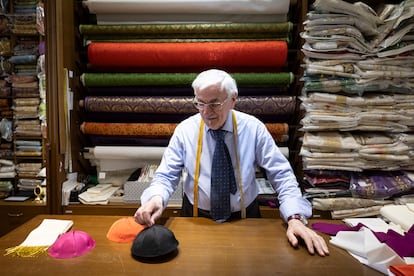
Mancinelli studied at a Salesian school as a child, where he learned the ecclesiastical tradition, which leaves little room for innovation, even in the cutting and tailoring of clerical vestments. He has been sewing for the clergy for 70 years and has no thought of retirement. At first, he made the vestments of priests, who later became bishops and later cardinals, spreading the virtues of his garments by word of mouth until his fame reached the ears of a pope.
On the wall of his workshop hangs a photo of him shaking Francis’s hand, while they both smile. He and the Argentine pontiff maintained a “very cordial” relationship. “He always smiled at me; he seemed more like a brother than a pope,” he recalls. And he emphasizes how difficult it was to sell him anything beyond the basics. “I tried to convince him, in vain, to at least wear white or light-colored pants under his cassock in the summer. I could make them for him with a light fabric, but there was no way; he always wore his black ones,” he notes.
The bustle of his small shop has been constant recently. Two employees are sewing the red buttons on a black cassock for a cardinal at one side of the counter, while another is serving a customer and explaining how to wash the stole he’s just bought. Another employee is on the phone: “I have to hang up, it’s busy here,” she apologizes. An Indian tourist enters the shop and asks to take a photo with the tailor, whom he saw on YouTube. A prelate stops by to pick up a sash he ordered last week, and tries on several amaranth-red skullcaps until he finds his size.
One of the many cardinals passing through Mancinelli’s shop could be the new pontiff. He recounts, laughing and with an enigmatic air: “A cardinal came to me a few days ago to ask me for a red cassock, which is what cardinals wear, and I told him: ‘Your Eminence, I won’t make it red, because if after the conclave you have to change color and wear white, what are you going to do with it?’ He laughed and said, ‘No, no, no,’ but he accepted my advice. Who knows?”

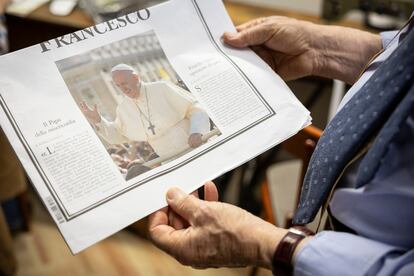



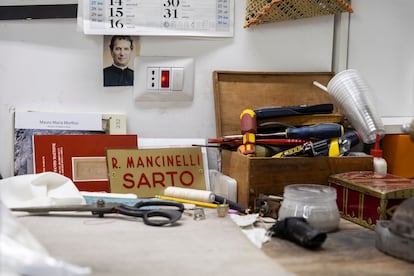
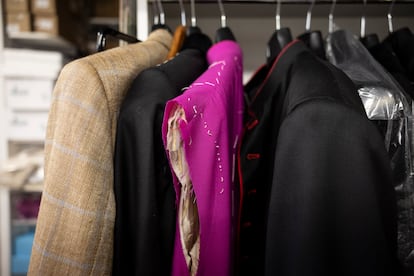
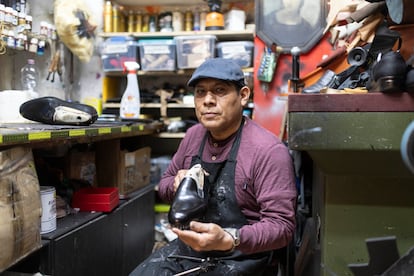
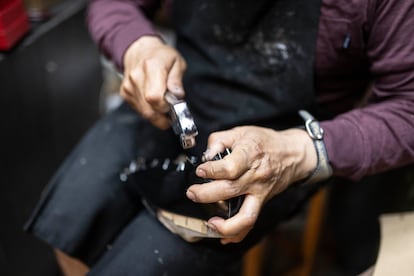
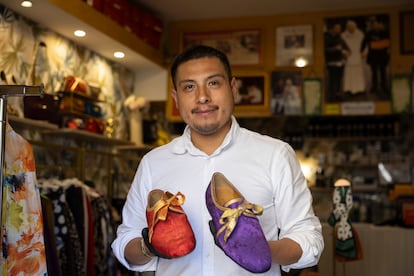
The golden mile of clerical fashion
Rome’s Via Borgo Pio and its surroundings form a sort of golden mile for clerical fashion in the Italian capital. It’s also home to the workshop of the man known as the “shoemaker of the popes.” Antonio Arellano, originally from Trujillo (Peru), has been in Italy for over three decades. In his small artisan shoe shop, he made John Paul II’s shoes and Benedict XVI’s famous red loafers. The German pontiff was a regular customer, even during his time as Pope Emeritus, following his resignation in 2013, explains the artisan, proudly showing a photo of the pontiff’s funeral chapel in which Arellano’s signature can be seen on the sole of the deceased’s shoes.
On the walls of his shop are newspaper clippings and numerous photos with Ratzinger. In one corner are stacked several copies of the book he himself wrote in 2019, entitled The Pope’s Shoemaker, in which he recounts his life, how he arrived in Italy, how he built a clientele among priests, bishops and nuns along the walls of the Vatican and how he became the shoemaker to two popes.
He remembers every detail of his illustrious clients. “John Paul II liked burgundy shoes, with pointed toes like these,” he recalls, showing off a pair. He knew Benedict XVI from his time as a cardinal; he had his measurements noted, and as pope, he ordered several red shoes. “He was very polite, very calm. He came here because I was the only shoemaker in this area,” he explains behind the counter, surrounded by shoes, belts, and other leather goods, while in the back room, his nephew works with shoe lasts and soles.
His son, Daniel Arellano, owns another shoe store, which he opened 17 years ago, also a short walk from the Vatican, but on the other side of St. Peter’s Square. He learned the trade from his father and repeatedly repaired Pope Francis’s briefcase and his orthopedic shoes, made by his trusted shoemaker in Argentina.
“They were comfortable, sanitary because he had some difficulty walking, black, simple, with simple laces. He brought them to replace the rubber in the sole or to have them polished,” he notes in his shop. He adds: “He took great care of his belongings, both his briefcase and his shoes. He liked to repair them when they were very worn rather than buying new ones. He brought his shoes from Argentina as a cardinal and continued to wear them throughout his pontificate. He had two models, but they were very similar.”

Francis was buried in a simple coffin with his pair of worn-out shoes, which had accompanied him for years and which were also repaired by Daniel Arellano. In his workshop, Daniel also lovingly repairs all kinds of leather goods, such as luxury handbags from Fendi and Louis Vuitton. “It’s nice that people continue to repair things. I hope the next pope will send a message in this direction, as Francis did. The throwaway culture and so much consumerism is not something to be admired,” he reflects.
Sign up for our weekly newsletter to get more English-language news coverage from EL PAÍS USA Edition
Tu suscripción se está usando en otro dispositivo
¿Quieres añadir otro usuario a tu suscripción?
Si continúas leyendo en este dispositivo, no se podrá leer en el otro.
FlechaTu suscripción se está usando en otro dispositivo y solo puedes acceder a EL PAÍS desde un dispositivo a la vez.
Si quieres compartir tu cuenta, cambia tu suscripción a la modalidad Premium, así podrás añadir otro usuario. Cada uno accederá con su propia cuenta de email, lo que os permitirá personalizar vuestra experiencia en EL PAÍS.
¿Tienes una suscripción de empresa? Accede aquí para contratar más cuentas.
En el caso de no saber quién está usando tu cuenta, te recomendamos cambiar tu contraseña aquí.
Si decides continuar compartiendo tu cuenta, este mensaje se mostrará en tu dispositivo y en el de la otra persona que está usando tu cuenta de forma indefinida, afectando a tu experiencia de lectura. Puedes consultar aquí los términos y condiciones de la suscripción digital.
More information
Archived In
Últimas noticias
All the effects of gentrification in one corner of Mexico’s Colonia Roma
Palestinian reporter Youmna El Sayed: ‘My family told me I had to choose between being a journalist or a mother’
The new language of the workplace: Knowing how to ask AI questions is more important than using it
Merz tries to replace Macron at the helm of Europe
Most viewed
- Christian Louboutin: ‘Young people don’t want to be like their parents. And if their parents wear sneakers, they’re going to look for something else’
- The low-cost creative revolution: How technology is making art accessible to everyone
- US sanctions against jailed cartel leader ‘El Marro’ highlight Mexico’s lack of control over its prisons
- Liset Menéndez de la Prida, neuroscientist: ‘It’s not normal to constantly seek pleasure; it’s important to be bored, to be calm’
- Cartels in Mexico take a leap forward with narco-drones: ‘It is criminal groups that are leading the innovation race’


